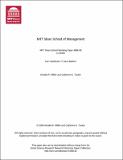| dc.contributor.author | Tucker, Catherine | |
| dc.contributor.author | Miller, Amalia | |
| dc.date.accessioned | 2011-08-25T18:42:24Z | |
| dc.date.available | 2011-08-25T18:42:24Z | |
| dc.date.issued | 2008-01-01 | |
| dc.identifier.uri | http://hdl.handle.net/1721.1/65368 | |
| dc.description.abstract | The US has a higher infant mortality rate than most other developed nations. Electronic
medical records (EMR) and other healthcare information technology (IT) improvements
could reduce that rate, by standardizing treatment options and improving
monitoring. We empirically quantify how healthcare IT improves neonatal outcomes.
We identify this effect through variations in state medical privacy laws that distort
the usefulness of healthcare IT. We find that adoption of healthcare IT by one additional
hospital in a county reduces infant mortality in that county by 13 deaths per
100,000 live births. Rough cost-effectiveness calculations suggest that healthcare IT is
associated with a cost of $450,140 per infant saved. | en_US |
| dc.language.iso | en_US | en_US |
| dc.publisher | Cambridge, MA; Alfred P. Sloan School of Management, Massachusetts Institute of Technology | en_US |
| dc.relation.ispartofseries | MIT Sloan School of Management Working Paper;4686-08 | |
| dc.subject | Electronic medical records | en_US |
| dc.subject | Healthcare IT | en_US |
| dc.title | Can Healthcare IT Save Babies? | en_US |
| dc.type | Working Paper | en_US |
